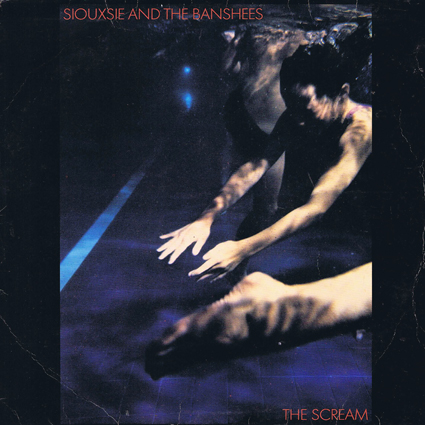
My favorite Siouxsie and the Banshees fact; the early band, primitivists to the core, ditched axe player Peter Fenton because he was a “real rock guitarist.” Can’t have one of those gussying up one’s primal punk rawk sound, not if one wants to create something truly unique and new. Which is what Siouxsie and the Banshees created with their celebrated 1978 debut, The Scream. So revolutionary was their music that critic Clinton Heylin held that the post-Fenton iteration of Siouxsie and the Banshees, along with the formation of PiL and Magazine, marked the “true starting point for English post-punk.”
On The Scream, Siouxsie Sioux (aka Susan Janet Ballion), guitarist and saxophonist John McKay, bassist Steven Severin, and drummer Kenny Morris created a sound that perfectly melded discord and harmony—a twitchy, spiky, and seemingly chaotic ruckus that was actually filled with beguiling melodies. Siouxsie’s vocals were by no means “pretty”—on The Scream she’s more attack dog than traditional female vocalist, and that’s a large part of the LP’s charm. But the real beauty of her vocals is the way they perfectly mesh with the band’s jagged yet catchy melodies; she’s in total synch with McKay’s remarkable guitar lines, and the pounding and throbbing of Morris and Severin on drums and bass, respectively.
McKay in particular is brilliant; I listen to his surprisingly ornate guitar work on, say, “Jigsaw Feeling,” and I marvel. The same goes for his magnificent guitar riff on “Carcass,” which is undoubtedly the catchiest song on The Scream. Between his guitar and Siouxsie’s alternately choppy and flowing vocals, this baby is a keeper, especially when you throw in the glam handclaps. His guitar work on the band’s cover of “Helter Skelter” is also a marvel; he meets Siouxsie’s stridently harsh vocals with a guitar that is more battering ram than six-stringed instrument, while Morris and Severin contribute to what is less a song than a wonderfully extended car crash. I love the song’s slow and clunky opening, and I can’t conceive of any finer moment than the one where Siouxsie sings, “You may be a lover but you ain’t no fucking dansa!”
Opener “Pure” is a slow and atmospheric combination of bass throb, simple guitar line, and way over there, in the far distance, Siouxsie, moaning. I like it but not nearly as much as I like the fast and discordant follow-up “Jigsaw Feeling,” on which Siouxsie sings off-kilter over a chiming McKay guitar that U2’s The Edge would filch, the felonious bastard. “Overground” comes from out of the underground, taking its good old time, McKay playing a simple guitar riff over which Siouxsie sings. I don’t really warm to the song until the drums and bass come in, and even then it’s my least favorite cut on the LP. “Mirage” opens with some lovely guitar work over which Siouxsie does some “normal” singing, and I love the way the song moves, the perfect soundtrack to a dance not yet invented.
“Metal Postcard (Mittageisen)” opens with some cool drum and bass before McKay tosses in some great power chords, and marches at midtempo while Siouxsie’s voice goes military, that is when she isn’t sending her vocals this way and that in what amounts to a bravura performance equal to her demented take on “Helter Skelter.” I particularly like her yips of “metal!” at the end, just as much as I like her frenetic and stuttering performance on speedy follow-up “Nicotine Stain,” on which she yips even more than she does on “Metal Postcard.” Meanwhile McKay plays more guitar that The Edge would steal, while Siouxsie sings, “Metal is tough, metal will sheen/Metal will rule in my master scheme” and the song segues into “Nicotine Stain,” a showcase for Siouxsie’s vocal pyrotechnics and McKay’s astounding guitar work, and makes me think of U2 (The Edge really should have to pay McKay royalties) and PiL engaging in a back alley brawl. Siouxsie stutters, sends her vocals into orbit, yips, and drags out just as many words as she snaps short.
“Nicotine Stain” is followed by the huge and wonderfully ponderous “Suburban Relapse,” a song inspired by the dystopian suburban visions of J.G. Ballard. Siouxsie barks and shouts, McKay plays sax in the background, and the tempo quickens while Morris and Severin perform miracles in the rhythm arena. The song ends with Siouxsie screaming “Relapse!” while McKay plays one final guitar flourish. Finally, closer “Switch” is a lovely tune, with Siouxsie singing the opening in a hushed voice to the accompaniment of some beautiful guitar by McKay. Then the pace picks up and slows down, a pattern that continues through the song. In the slow sections Siouxsie’s voice becomes a doleful drone, and McKay plays that lovely guitar riff. In the faster sections, Morris beats out a tattoo on the drums while Siouxsie’s voice soars. It’s a wonderful closer, atmospheric and ambitious, what with Siouxsie’s voice going plays nobody else’s could go as she sings, “They’re dying to switch/Switch/Switch.”
Siouxsie and the Banshees would go on to record lots of great songs, including the middle eastern-flavored “Kiss Them for Me,” a stunningly lovely cover of the Beatles’ “Dear Prudence,” the 14 majestically droning minutes of yodel and howl that make up “The Lord’s Prayer,” and the cooler-than-words “Premature Burial.” Me, I love their rough and primal music the most, and I’ll take the strident “Playground Twist” over their later music any day. But their later, more polished material has its charms too, as the cool piano on 1984’s “Swimming Horses,” to pull just one example out of a hat, proves. In short, they’re one of the few bands that grew up without growing intolerably complacent and slick, and while I’m not big on evolution (it created loathsome mankind, after all) in the case of Siouxsie and the Banshees evolution worked just fine. If only mankind had evolved as well.
GRADED ON A CURVE:
A-














































